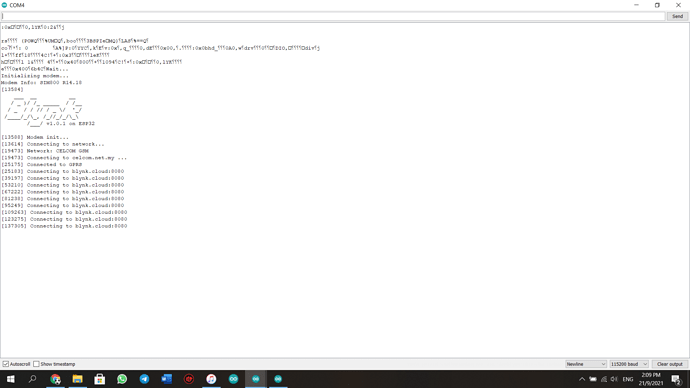Hello everybody in the Blynk.Community,
I am currently using the TTGO T-Call ESP32 SIM800L device and it can’t seem to be connected to the Blynk cloud.
The coding, fortunately, can be uploaded into the device but the cloud/dashboard is still waiting for the device to be connected.
I have used the Blynk > Boards_GSM > TinyGSM_SIM800_SIM900 example that is in the Arduino IDE.
This is my coding:
#define BLYNK_PRINT Serial
/* Fill-in your Template ID (only if using Blynk.Cloud) */
#define BLYNK_TEMPLATE_ID "TMPLDAg-UKvi"
#define BLYNK_DEVICE_NAME "Quickstart Device"
#define BLYNK_AUTH_TOKEN "jCIBo3HvkieM6NBzqhM1QlZJbA45F8wC";
// Please select the corresponding model
#define SIM800L_IP5306_VERSION_20190610
// Select your modem:
#define TINY_GSM_MODEM_SIM800
// Default heartbeat interval for GSM is 60
// If you want override this value, uncomment and set this option:
// #define BLYNK_HEARTBEAT 30
#include <TinyGsmClient.h>
#include <BlynkSimpleTinyGSM.h>
// You should get Auth Token in the Blynk App.
// Go to the Project Settings (nut icon).
char auth[] = "jCIBo3HvkieM6NBzqhM1QlZJbA45F8wC";
// Your GPRS credentials
// Leave empty, if missing user or pass
char apn[] = "celcom.net.my";
char user[] = "";
char pass[] = "";
// Hardware Serial on Mega, Leonardo, Micro
#define SerialAT Serial1
// Set serial for debug console (to the Serial Monitor, default speed 115200)
#define SerialMon Serial
// Define the serial console for debug prints, if needed
#define TINY_GSM_DEBUG SerialMon
// or Software Serial on Uno, Nano
//#include <SoftwareSerial.h>
//SoftwareSerial SerialAT(2, 3); // RX, TX
#include "utilities.h"
#define relay1 18
#define relay2 14
#define relay3 15
#define relay4 19
#ifdef DUMP_AT_COMMANDS
#include <StreamDebugger.h>
StreamDebugger debugger(SerialAT, SerialMon);
TinyGsm modem(debugger);
#else
TinyGsm modem(SerialAT);
#endif
TinyGsmClient client(modem);
BLYNK_WRITE(V0)
{
int pinValue = param.asInt(); // assigning incoming value from pin V1 to a variable
digitalWrite(relay1, !pinValue);
delay(1000);
// process received value
}
BLYNK_WRITE(V1)
{
int pinValue = param.asInt(); // assigning incoming value from pin V1 to a variable
digitalWrite(relay2, !pinValue);
// process received value
}
BLYNK_WRITE(V2)
{
int pinValue = param.asInt(); // assigning incoming value from pin V1 to a variable
digitalWrite(relay3, !pinValue);
// process received value
}
BLYNK_WRITE(V3)
{
int pinValue = param.asInt(); // assigning incoming value from pin V1 to a variable
digitalWrite(relay4, !pinValue);
// process received value
}
void setup()
{
// Debug console
Serial.begin(115200);
pinMode(relay1, OUTPUT);
pinMode(relay2, OUTPUT);
pinMode(relay3, OUTPUT);
pinMode(relay4, OUTPUT);
digitalWrite(relay1, HIGH);
digitalWrite(relay2, HIGH);
digitalWrite(relay3, HIGH);
digitalWrite(relay4, HIGH);
delay(10);
setupModem();
SerialMon.println("Wait...");
// Set GSM module baud rate and UART pins
SerialAT.begin(115200, SERIAL_8N1, MODEM_RX, MODEM_TX);
delay(6000);
// Restart takes quite some time
// To skip it, call init() instead of restart()
SerialMon.println("Initializing modem...");
modem.restart();
// modem.init();
String modemInfo = modem.getModemInfo();
SerialMon.print("Modem Info: ");
SerialMon.println(modemInfo);
// Unlock your SIM card with a PIN
//modem.simUnlock("1234");
Blynk.begin(auth, modem, apn, user, pass);
}
void loop()
{
Blynk.run();
}
utilities.h coding:
#include <Wire.h>
#if defined(SIM800L_IP5306_VERSION_20190610)
#define MODEM_RST 5
#define MODEM_PWRKEY 4
#define MODEM_POWER_ON 23
#define MODEM_TX 27
#define MODEM_RX 26
#define I2C_SDA 21
#define I2C_SCL 22
#define LED_GPIO 13
#define LED_ON HIGH
#define LED_OFF LOW
#define IP5306_ADDR 0x75
#define IP5306_REG_SYS_CTL0 0x00
// setPowerBoostKeepOn
bool setupPMU()
{
bool en = true;
Wire.begin(I2C_SDA, I2C_SCL);
Wire.beginTransmission(IP5306_ADDR);
Wire.write(IP5306_REG_SYS_CTL0);
if (en) {
Wire.write(0x37); // Set bit1: 1 enable 0 disable boost keep on
} else {
Wire.write(0x35); // 0x37 is default reg value
}
return Wire.endTransmission() == 0;
}
#elif defined(SIM800L_AXP192_VERSION_20200327)
#define MODEM_RST 5
#define MODEM_PWRKEY 4
#define MODEM_POWER_ON 23
#define MODEM_TX 27
#define MODEM_RX 26
#define MODEM_DTR 32
#define MODEM_RI 33
#define I2C_SDA 21
#define I2C_SCL 22
#define LED_GPIO 13
#define LED_ON HIGH
#define LED_OFF LOW
#elif defined(SIM800C_AXP192_VERSION_20200609)
// pin definitions
#define MODEM_PWRKEY 4
#define MODEM_POWER_ON 25
#define MODEM_TX 27
#define MODEM_RX 26
#define MODEM_DTR 32
#define MODEM_RI 33
#define I2C_SDA 21
#define I2C_SCL 22
#define LED_GPIO 12
#define LED_ON LOW
#define LED_OFF HIGH
#elif defined(SIM800L_IP5306_VERSION_20200811)
#define MODEM_RST 5
#define MODEM_PWRKEY 4
#define MODEM_POWER_ON 23
#define MODEM_TX 27
#define MODEM_RX 26
#define MODEM_DTR 32
#define MODEM_RI 33
#define I2C_SDA 21
#define I2C_SCL 22
#define LED_GPIO 13
#define LED_ON HIGH
#define LED_OFF LOW
#define IP5306_ADDR 0x75
#define IP5306_REG_SYS_CTL0 0x00
// setPowerBoostKeepOn
bool setupPMU()
{
bool en = true;
Wire.begin(I2C_SDA, I2C_SCL);
Wire.beginTransmission(IP5306_ADDR);
Wire.write(IP5306_REG_SYS_CTL0);
if (en) {
Wire.write(0x37); // Set bit1: 1 enable 0 disable boost keep on
} else {
Wire.write(0x35); // 0x37 is default reg value
}
return Wire.endTransmission() == 0;
}
#else
#error "Please select the corresponding model"
#endif
#if defined(SIM800L_AXP192_VERSION_20200327) || defined(SIM800C_AXP192_VERSION_20200609)
#include <axp20x.h> //https://github.com/lewisxhe/AXP202X_Library
AXP20X_Class axp;
bool setupPMU()
{
// For more information about the use of AXP192, please refer to AXP202X_Library https://github.com/lewisxhe/AXP202X_Library
Wire.begin(I2C_SDA, I2C_SCL);
int ret = axp.begin(Wire, AXP192_SLAVE_ADDRESS);
if (ret == AXP_FAIL) {
Serial.println("AXP Power begin failed");
return false;
}
//! Turn off unused power
axp.setPowerOutPut(AXP192_DCDC1, AXP202_OFF);
axp.setPowerOutPut(AXP192_LDO2, AXP202_OFF);
axp.setPowerOutPut(AXP192_LDO3, AXP202_OFF);
axp.setPowerOutPut(AXP192_DCDC2, AXP202_OFF);
axp.setPowerOutPut(AXP192_EXTEN, AXP202_OFF);
//! Do not turn off DC3, it is powered by esp32
// axp.setPowerOutPut(AXP192_DCDC3, AXP202_ON);
// Set the charging indicator to turn off
// Turn it off to save current consumption
// axp.setChgLEDMode(AXP20X_LED_OFF);
// Set the charging indicator to flash once per second
// axp.setChgLEDMode(AXP20X_LED_BLINK_1HZ);
//! Use axp192 adc get voltage info
axp.adc1Enable(AXP202_VBUS_VOL_ADC1 | AXP202_VBUS_CUR_ADC1 | AXP202_BATT_CUR_ADC1 | AXP202_BATT_VOL_ADC1, true);
float vbus_v = axp.getVbusVoltage();
float vbus_c = axp.getVbusCurrent();
float batt_v = axp.getBattVoltage();
// axp.getBattPercentage(); // axp192 is not support percentage
Serial.printf("VBUS:%.2f mV %.2f mA ,BATTERY: %.2f\n", vbus_v, vbus_c, batt_v);
return true;
}
#endif
void setupModem()
{
// Start power management
if (setupPMU() == false) {
Serial.println("Setting power error");
}
#ifdef MODEM_RST
// Keep reset high
pinMode(MODEM_RST, OUTPUT);
digitalWrite(MODEM_RST, HIGH);
#endif
pinMode(MODEM_PWRKEY, OUTPUT);
pinMode(MODEM_POWER_ON, OUTPUT);
// Turn on the Modem power first
digitalWrite(MODEM_POWER_ON, HIGH);
// Pull down PWRKEY for more than 1 second according to manual requirements
digitalWrite(MODEM_PWRKEY, HIGH);
delay(100);
digitalWrite(MODEM_PWRKEY, LOW);
delay(1000);
digitalWrite(MODEM_PWRKEY, HIGH);
// Initialize the indicator as an output
pinMode(LED_GPIO, OUTPUT);
digitalWrite(LED_GPIO, LED_OFF);
}
And this is what is being displayed in my serial monitor:
I would like to know what can I do to be able to connect this device with the Blynk cloud.
Thank you so much for your time and considerations.



